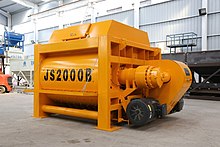This article needs additional citations for verification. (October 2012) |

A concrete plant, also known as a batch plant or batching plant or a concrete batching plant, is equipment that combines various ingredients to form concrete. Some of these inputs include water, air, admixtures, sand, aggregate (rocks, gravel, etc.), fly ash, silica fume, slag, and cement. A concrete plant can have a variety of parts and accessories, including: mixers (either tilt drum or horizontal, or in some cases both), cement batchers, aggregate batchers, conveyors, radial stackers, aggregate bins, cement bins, heaters, chillers, cement silos, batch plant controls, and dust collectors.
The heart of the concrete batching plant is the mixer, and there are many types of mixers, such as tilt drum, pan, planetary, single shaft and twin shaft. The twin shaft mixer can ensure an even mixture of concrete through the use of high horsepower motors, while the tilt mixer offers a comparatively large batch of concrete mix. In North America, the predominant central mixer type is a tilt drum style, while in Europe and other parts of the world, a twin shaft mixer is more prevalent. A pan or planetary mixer is more common at a precast plant.
Aggregate bins have 2 to 6 compartments for storage of various sand and aggregate (rocks, gravel, etc.) sizes, while cement silos are typically one or two compartments, but at times up to 4 compartments in a single silo. Conveyors are typically between 24 and 48 inches wide and carry aggregate from the ground hopper to the aggregate bin, as well as from the aggregate batcher to the charge chute.

The aggregate batcher, also named aggregate bins, is used for storage and to batch the sand, gravel and crushed stone of the concrete plant. There are also many types of aggregate batchers, but most of them measure aggregate by weighing. Some use a weighing hopper, some use a weighing belt.
The cement silos are indispensable devices in the production of concrete. They mainly store bulk cement, fly ash, mineral powder and others. There are three types of cement silos: bolted cement silos, horizontal cement silos and integrated cement silos. Integrated cement silos are made in factories, and can be used directly. Bolted cement silos are bolted for easy installation and removal. Horizontal cement silos have lower requirements on foundations and can be transported by truck or flatbed without disassembly.

The screw conveyor is a machine to transfer the materials from the cement silos to the powder weighing hopper.

Concrete plants use the control system to control the working of the machine. Concrete batch plants employ computer aided control to assist in fast and accurate measurement of input constituents or ingredients. With concrete performance so dependent on accurate water measurement, systems often use digital scales for cementitious materials and aggregates, and moisture probes to measure aggregate water content as it enters the aggregate batcher to automatically compensate for the mix design water/cement ratio target. Many producers find moisture probes work well only in sand, and with marginal results on larger sized aggregate.
